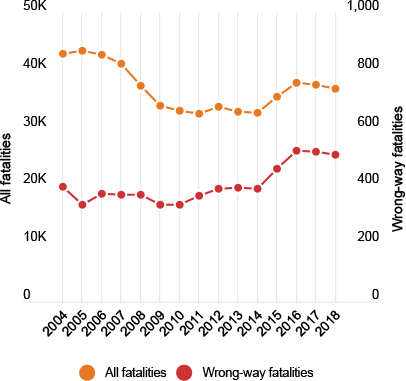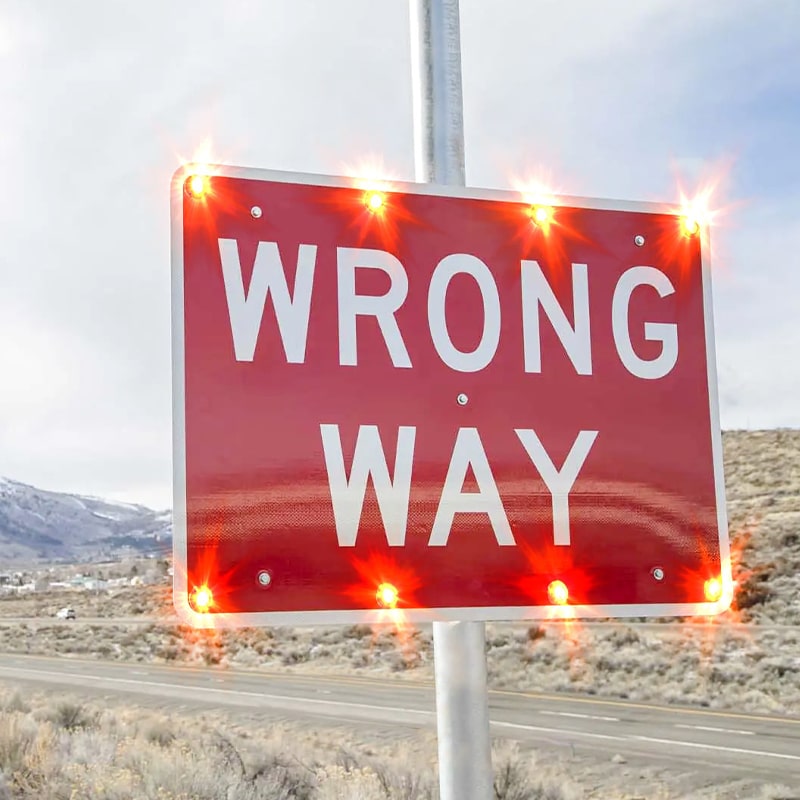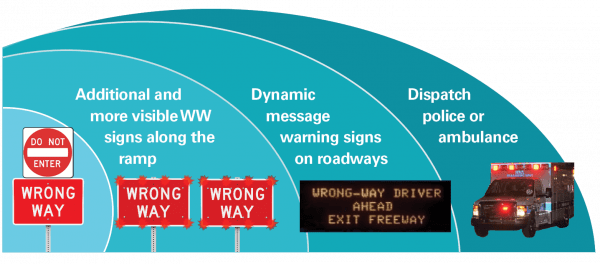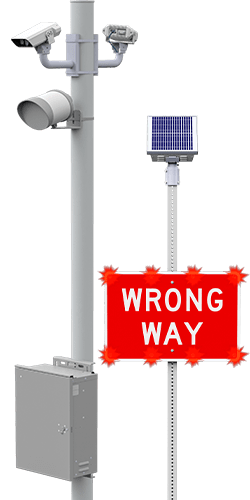MX SeriesTM
Wrong Way Detection System
Wrong-way driver alert systems increase self-correction and speed response times with a complete, configurable, and effective defense against wrong-way driving.
What causes wrong-way driving?
Wrong way driving + connectivity:
WWD-MX
Our newest MX Series Wrong-Way Driving Signs improve driver awareness and encourage self-correction. Adding optional radar can trigger additional warnings and record data for analysis.
Here’s what you get with an MX RRFB:
- 3 years of free remote connectivity
- Actionable email and text alerts
- Remote system access via MX Cloud™
- Quick setup and local access with MX Field App™
- ‘Smart module’ design for simple installation and richer data
- Solar Power Report (SPR) prepared for every location
- Options for overhead lighting and accessible push buttons

Meets MUTCD Standards

Buy America / BABA compliant

3-year system warranty

Every MX system ships with 3 years free remote connectivity.
With MX, connectivity isn’t an add-on. We’ve embedded it into the hardware so that it automatically connects and reports to the cloud (and a free local app) the moment it receives power.
MX Lite
Get actionable alerts and a network-wide view of your systems.
3 Years Free | $79/year at year 4
Features (Core)
- Out-of-the-box connectivity
- System alerts (email/text)
- Remote asset management with GPS map view and more
RECOMMENDED
MX Plus
Make changes to your system settings and access data from anywhere.
$99/year
All MX Lite features and
- Remote programming
- Knockdown alerts
- Data Charting
- …and more
MX Pro
Create, edit and set schedules in bulk and on-the-fly.
$249/year
All MX Plus features and
- Remote scheduling
- 5-year historical data
- Export functionality
- …and more
Wrong-way driving research: from risk analysis to prevention tools
Check out our Wrong-Way Driving Research Guide to better understand the wrong-way driving problem and potential mitigation strategies. It contains links to studies, briefs, and articles that cover topics such as:
- Risk factors such as driver age, impairment, and gender. Drivers impaired by alcohol and older drivers are over-represented in wrong-way crashes.
- The time and day of the week play a significant role in wrong-way collisions. A disproportionate number of these incidents occur on the weekends and during the dark hours of the day, typically between midnight and 6 a.m.
- Types of interchange—The primary origin of wrong-way driving on freeways is when drivers enter the freeway at an interchange exit ramp rather than correctly entering at an entrance ramp.
- Statistics on incidents and fatalities – including a state-by-state breakdown
- WWD prevention – including roadway design, signs, lighting, driver education and enforcement
- Vehicle Detection Systems for prevention


Wrong-way crashes remain a significant safety concern
According to data from the National Transportation Safety Board, wrong-way crashes claim an average of 359 lives each year in the U.S. And while overall vehicle crash deaths have declined in the past decade, wrong-way crashes have maintained their deadly toll. Some states have even seen an uptick in wrong-way crashes.

Are current solutions working?
Statistics indicate that most current treatments are not significantly effective. As states have observed an increase in wrong-way crashes, many have increased their investment in a combination of countermeasures. These measures include WRONG WAY and DO NOT ENTER signs, pavement markings, overhead lighting, and enhanced retroreflectivity.
Despite these efforts, WWD crashes and fatalities are not decreasing, even as overall traffic fatalities have dropped significantly.

Experimental countermeasures
Some states have deployed new countermeasures that use a variety of technologies and off-the-shelf components with varying success.
- Arkansas’ $3.1 million sign and pavement marking upgrades had no effect on the number of crashes
- Texas’ 22-month study of LED-enhanced signs found a 38% reduction in WWD events
- Nevada’s 46 LED light bar systems (which were approved under a request for experiment) were “80% effective in stopping wrong-way drivers,” according to preliminary results

Vehicle detection and alert systems are up to 80% effective in stopping wrong-way drivers
In Nevada, 75 people died in wrong-way driving crashes between 2005 and 2015. Dissatisfied with the performance of plain signage and pavement markings, NDOT doubled down on its countermeasure efforts, piloting 46 experimental detection and alert systems that feature the same high-intensity light bars used in Carmanah’s RRFB crosswalk systems. Research is ongoing, but preliminary results showed they were up to 80% effective preventing wrong-way collisions.

Detection and Alert Technologies
In higher-risk locations, relying on wrong-way drivers to self-correct or on other drivers to report them is dangerous and time-consuming. Adding layers of safety measures with wrong-way detection and alert systems significantly reduces the risk of fatal crashes.
Vehicle detection systems are up to 80% effective*
Wrong-Way Vehicle Detection, Warning, and Alert Systems provide instant detection and rapid response:
- Radar Detection: Radar units detect wrong-way vehicles and trigger high-intensity LED warning signs.
- Camera Analytics: High-definition cameras perform analytics to confirm the wrong-way vehicle.
- Immediate Alerts: Alerts are instantly sent to traffic management centers and law enforcement to intercept wrong-way drivers.
- Rapid Deployment: First responders are quickly deployed to address the situation.
*Nevada DOT, Wrong Way Driver System, preliminary research press release
Additional resources for wrong-way driver systems
Article
Wrong-Way Driving: Facts and Effective Countermeasures: Read our primer on the problem of wrong-way driving in the U.S., its causes, and proactive measures states can take to reduce this deadly crash type.
Case Study
Nevada uses Carmanah light bars to combat wrong-way driving: See how an experimental detection and alert system in Reno is helping prevent wrong-way driver situations before they become dangerous.
Article
Arizona Turns to Technology to Turn Wrong-Way Drivers Around: Faced with a serious and worsening public safety threat, Arizona has taken extensive steps to counter wrong-way driving, including detection technology.
Article
Wrong-Way Driving: Facts and Effective Countermeasures: Read our primer on the problem of wrong-way driving in the U.S., its causes, and proactive measures states can take to reduce this deadly crash type.
Case Study
Nevada uses Carmanah light bars to combat wrong-way driving: See how an experimental detection and alert system in Reno is helping prevent wrong-way driver situations before they become dangerous.
Article
Arizona Turns to Technology to Turn Wrong-Way Drivers Around: Faced with a serious and worsening public safety threat, Arizona has taken extensive steps to counter wrong-way driving, including detection technology.
Wrong-way driving countermeasures
Carmanah’s intelligent wrong-way driving alert and detection systems offer customizable, proactive solutions to encourage driver self-correction. Build your solution using WWD-MX-connected signs, beacons, and optional radar, or opt for advanced vehicle detection, warning and alert system for high-risk areas.
WWD-MX
WW400
Advanced wrong-way vehicle detection, warning and alert system for highway off-ramps with high crash rates.

WWD-MX
WW400
Advanced wrong-way vehicle detection, warning and alert system for highway off-ramps with high crash rates.

Get in touch
Have questions or need assistance? Connect with sales for product inquiries and quotes, support for technical issues, or visit the product support center for self-service resources.